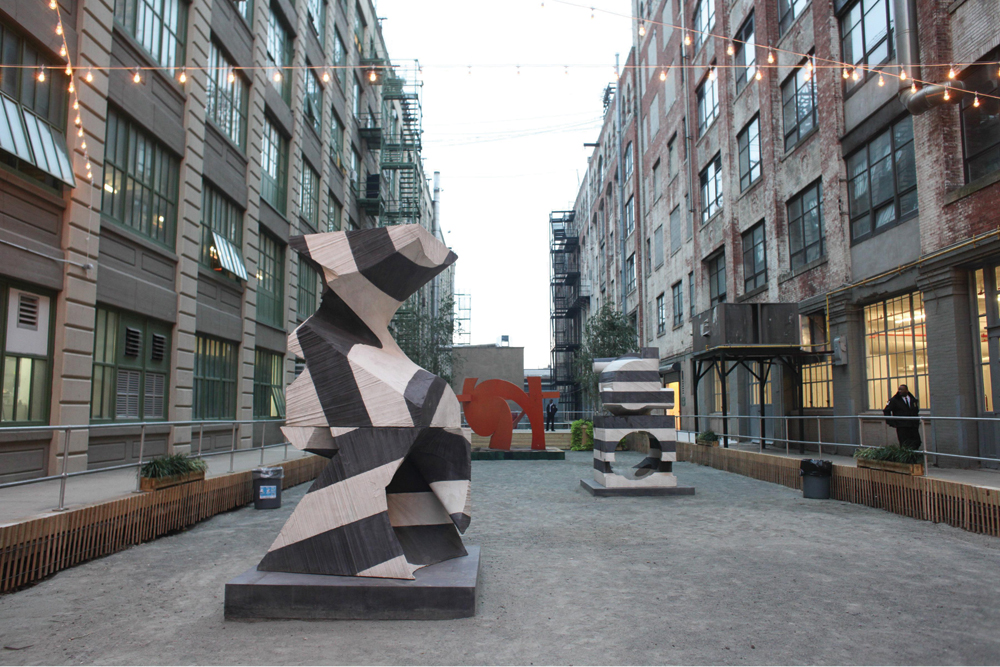« Reviews
Come Together: Surviving Sandy
Industry City - Brooklyn, New York
By Stephen Truax
“Come Together: Surviving Sandy“ is the largest independently organized exhibition in New York in recent memory. It was organized by Phong Bui, an artist as well as the founder, and publisher of the Brooklyn Rail. Bui’s studio was tragically submerged during Hurricane Sandy and he lost years of his own work. The massive exhibition includes 331 artists and more than 850 works in a nearly 100,000-square-foot space; it includes an extraordinary outdoor sculpture garden, which features works by Mel Kendrick (pictured), Mark di Suvero, and Joel Shapiro and Lee Tribe.
No exhibition of this scope has happened in Brooklyn since the early 1980s, and “Come Together“ dwarfs even them, according to artist and art historian Loren Munk.1 His diagrammatic paintings, which are included in the show, seek to map the New York art community and art history. He told me that he was honored to be included and that the exhibition is “one of the most historical shows that has ever happened in Brooklyn.”2

Installation view of “Come Together: Surviving Sandy, Year 1” at Industry City, Brooklyn NY. October 20 – December 15, 2013. Photos: Paul Porter and Alexander Porter. Courtesy of Billy Farrell Agency.
It is comparable in scope to the annual Armory Show, a commercial art fair, the museum-wide Whitney Biennial, or the Venice Biennale’s Arsenale. Some of the artists included-Chuck Close, Alex Katz, Richard Serra, Rackstraw Downes, to name a few-are familiar names in such high-profile exhibitions. It also includes some of New York’s most exciting younger artists, such as Josephine Halvorson, EJ Hauser, Eli Ping, Nathalie Provosty, Adrianne Rubinstein, Gary Stephan, and the Bruce High Quality Foundation.
The quality of the exhibition is unprecedented, with a strong focus on painting, such as Katherine Bradford, Lois Dodd, Tamara Gonzales, Deborah Kass, Ronnie Landfield, Chris Martin, Carrie Moyer, Thomas Nozkowski, John Walker, and Terry Winters. The video works were equally compelling, including Sojah Azari’s 25-minute video projection, The King of Black (2013), which blends Persian paintings with live action film, and Superflex’s horrifying Flooded McDonald’s (2008).
“Come Together“ commemorates the first anniversary of Hurricane Sandy, which is estimated to have cost $68 billion,3 the second most costly in U.S. history, after Katrina. In New York, the storm inundated artists’ studios and powerful commercial galleries alike. It damaged or destroyed an immeasurable amount of art. “Come Together“ offers free, professional consultations for artists on the conservation of work affected by flooding damage. No single event has affected the New York art community so dramatically since 9/11. It is not, however, a thematic show about the tragedy; the message of recovery is a jumping off point.
Artists are featured in large salon-style exhibitions within the mega show, “The Beauty of Friends Coming Together,” which underscores a democratic selection process and a commitment to the community. Approximately 100 artists were selected by the Rail to be exhibited in these salons, and each of them were requested to recommend an artist affected by the Hurricane to be exhibited alongside them, making 217 artists in total.
Almost all work is for sale. No commission will be taken from any sales; collectors are put in contact with the artists and their representative galleries. The artists are encouraged to donate a small portion of the proceed from sales to the Rail, a free newspaper, and a 501(c)(3) nonprofit organization. These donations will go to the Rail, Sandy relief funds, local art education programs in Sunset Park, and to the Dedalus Foundation, which co-sponsored the exhibition and, among its many activities, provides grants directly to artists and nonprofits. Industry City, a 19th century industrial property now spanning 40 acres, donated the space to the Rail for free as part of its ongoing effort to maintain strong relationships with local art community. 4 5
A show of this magnitude would have taken a major institution years to plan and execute. Bui did it in a little over three months, with the help of the participating artists, a dozen freelance art handlers, volunteers and three curatorial assistants.
Bui told me, “It is the curator’s role to amplify the artist’s message, and to enhance the understanding of the public” and, drawing from the etymology of the word “curator,” he continued, “to protect the sacredness of the work of art, the spiritual dimension of artistic practice.”6
It would be difficult to overstate the significance of Bui’s contribution to the New York art community. The Rail has become an invaluable resource, considered by many to be the lingua franca of contemporary critical dialog on art in New York. This exhibition cements not only the New York art community’s refusal to be defeated by the storm, but captures an important art historical moment, like a time capsule, preserved from any future catastrophe.
(October 20 - December 15, 2013)
NOTES
1. Kalm, James/Munk, Loren. “The Brooklyn Canon: Airbrushed Out of History.” Brooklyn Rail, June, 2008.
2. Interview with artist Loren Munk. October 28, 2013.
3. Hurricane/Post-Tropical Cyclone Sandy, October 22-29, 2012 (Service Assessment). United States National Oceanic and Atmospheric Administration’s National Weather Service. May 2013. p. 10. Archived from the original on June 2, 2013.
4. Interview with Industry City CEO, Andrew Kimball. October 28, 2013.
5. Soskolne, Lisa. “Who Owns a Vacant Lot? Orthodoxy vs. Culture Industry.” Shifter magazine. Issue 21: Other Spaces. October, 2013.
6. Interview with the curator, Phong Bui. October 29, 2013.
Stephen Truax is a conceptual artist and curator based in Brooklyn.
Filed Under: Reviews




































Leave a Reply
You must be logged in to post a comment.